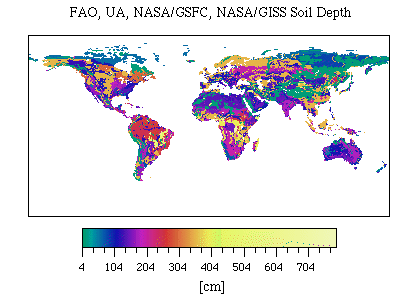ISLSCP INITIATIVE I
 〔NASA
GES DISC Homeの『ISLSCP INITIATIVE I』から〕 |
『Abstract
Global data sets of rooting depths, long-term means of monthly
precipitation and potential evapotranspiration, and soil texture
were used to predict the probability of deep rooting around the
globe. Rooting depths were considered to be deep if 5% or more
of all roots in a profile were located below 2m depth. Spatially
explicit global predictions were based on empirical models relating
the probability of deep rooting with climate and soil texture.
Based on these predictions, deep roots are most likely to occur
in seasonally dry, semiarid to humid tropical regions under savanna
or thorn-scrub vegetation or under seasonally dry semideciduous
to evergreen forests. Deep roots are least likely to occur in
arctic, boreal or cool-temperature regions and in per-humid climates
such as equatorial rain forests. Under warm-temperature to tropical
climates, rooting depths are more likely to be deep in coarse-textured
and fine-textured soil than in soils of medium texture. These
observations agree well with predictions based on a previously
published conceptual model, according to which water infiltration
depths and evaporative demand are the main climatic factors to
determine vertical root distributions on a global scale.
Keywords: Roots; Rooting depths; Global maps; Global root distributions;
Natural vegetation; Evapotranspiration; Soil texture; Soil water
balance 』
『要旨
根の深さ、月降水量と可能な蒸発散の長期平均、および土性についての世界的なデータ・セットが、世界的な深い根の可能性を予測するために使われた。もし断面ですべての根の5%以上が2メートルより深くにあれば、根の深さは深いと考慮された。空間的に明確な世界的予測は、深い根の可能性を気候と土性に関連づける経験的なモデルに基づいて行われた。これらの予測によれば、深い根は、サバンナまたは有刺低木林の植生下あるいは季節的に乾燥する半落葉樹〜常緑樹の森林下で、季節的に乾燥する亜乾燥〜湿潤熱帯地域にもっとも生じやすい。深い根は、極地または亜寒帯または低温地域、および赤道付近の多雨林のような過湿な気候ではもっとも生じにくい。温暖〜熱帯気候下では、中粒の土性よりも粗粒や細粒の土壌で深い根をもちやすい。これらの観察は、従来報告されている概念モデルに基づいた予測とよくあい、それによれば、水の浸透の深さと蒸発の激しさが、世界的規模での垂直方向の根の分布を決める主な気候的要因である。』
1. Introduction
2. Material and methods
2.1. Databases used in the study
2.2. Mathematical models and statistical analyses
3. Results
4. Discussion
Acknowledgments
References
 〔NASA
GES DISC Homeの『ISLSCP INITIATIVE I』から〕 |